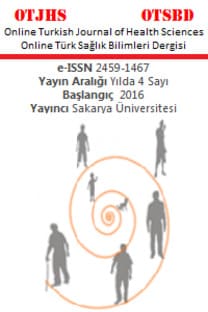Dev Omfalosel: 23 Hasta; Üç Farklı Yaklaşım
Dev Omfalosel, silo, birincil kapama, VDK
Giant Omphalocele: 23 Patients; Three Different Approaches
Giant omphalocele, primary closure, silo, VAC,
___
- Binet A, Scalabre A, Amar S, et al. Operative versus conservative treatment for giant omphalocele: study of French and Ivorian management. Ann Chir Plast Esthet. 2019;65:147-153.
- Roux N, Jakubowicz D, Salomon L, et al. Early Surgical Management for Giant Omphalocele: Results and Prognostic Factors. J. Pediatr. Surg. 2018;53(10):1908-1913.
- Pelizzo G, Maso G, Dell’Oste C, et al. Giant omphaloceles with a small abdominal defect:prenatal diagnosis and neonatal management. Ultrasound Obstet Gynecol. 2005;26:786-788.
- Bauman B, Stephens D, Gershone H, et al. Management of giant omphaloceles: a systematic review of methods of staged surgical vs. nonoperative delayed closure. J Pediatr Surg. 2016;51:1725-1730.
- Ein SH, Langer JC. Delayed management of giant omphalocele using silver sulfadiazine cream: an 18-year experience. J Pediatr Surg. 2012;47:494-500.
- Akinkuotu AC, Sheikh F, Olutoye OO, et al. Giant omphaloceles: surgical management and perinatal outcomes. J Surg Res. 2015;198:388-392.
- Skarsgard ED: Immediate versus staged repair of omphaloceles. Semin Pediatr Surg. 2019;28:89-94.
- Duggan E, Puligandla PS. Respiratory disorders in patients with omphalocele. Semin Pediatr Surg. 2019;28:115-117.
- Dingemann C, Sonne M, Ure B, Bohnhorst B, von Kaisenberg C, Pirr S. Impact of maternal education on the outcome of newborns requiring surgery for congenital malformations. Plos One. 2019;14(4): e0214967.
- Chakhunashvili DG, Lomidze N, Karalashvili L, Kikalishvili L, Chakhunashvili K, Kakabadze Z. Challenges and management of congenital abdominal wall defects (Review). Georgian Med News. 2018;24-33.
- Mehmet Eliçevik. Karın Ön Duvarı Anomalileri. Turk Arch Ped. 2010;45 Suppl:29-34.
- Ozkan B, Markal Ertas N, Bali U, et al. Clinical Experiences with Closed Incisional Negative Pressure Wound Treatment on Various Anatomic Locations. Cureus. 2020;12(6): e8849. doi: 10.7759/cureus.8849
- Ahmet Demir at al. Topikal Negatif Basınç (Vakum yardımlı kapama) (VAC) uygulamalarımız. Türk Plast Rekons Est Cer Dergisi. 2006;14(3):171-177.
- Seidel D, Diedrich S, Herrle F, et al. Negative Pressure Wound Therapy vs Conventional Wound Treatment in Subcutaneous Abdominal Wound Healing Impairment: The SAWHI Randomized Clinical Trial. JAMA Surg. 2020;155(6)469-478.
- Maksoud-Filho JG, Tannuri U, Da Silva MM, et al. The outcome of newborns with abdominal wall defects according to the method of abdominal closure: the experience of a single center. Pediatr Surg Int. 2006;22:503-507.
- Charlesworth P, Ervine E, McCullagh M. Exomphalos major: the Northern Ireland experience. Pediatr Surg Int. 2009;25:77-81.
- Pereira RM, Tatsuo ES, Simões E Silva AC, et al. New method of surgical delayed closure of giant omphaloceles: Lazaro da Silva’s technique. J Pediatr Surg. 2004;39:1111-1115.
- Van Eijck FC, de Blaauw I, Bleichrodt RP, et al. Closure of giant omphaloceles by the abdominal wall component separation technique in infants. J Pediatr Surg. 2008;43:246-250.
- Bauman B, Stephens D, Gershone H, et al. Management of giant omphaloceles: a systematic review of methods of staged surgical vs. nonoperative delayed closure. J Pediatr Surg. 2016;51:1725-1730.
- Malhotra S, Kumta S, Bhutada A, Jacobson-Dickman E, Motaghedi R. Topical Iodine-Induced Thyrotoxicosis in a Newborn with a Giant Omphalocele. AJP Rep. 2016;6(2):e243-e245. doi:10.1055/s-0036-1584879
- Eltayeb AA, Mostafa MM. Topical treatment of major omphalocoele: Acacia nilotica versus povidone-iodine: a randomised controlled study. Afr J Paediatr Surg. 2015;12:241-246.
- Tran DA, Truong QD, Nguyen MT. Topical application of povidone-iodine solution (Betadine)in the management of giant omphaloceles. Dermatology. 2006;212:88-90.
- ISSN: 2459-1467
- Yayın Aralığı: Yılda 4 Sayı
- Başlangıç: 2016
- Yayıncı: Oğuz KARABAY
Ortodontiye İlişkin Dünya Genelindeki İnternet Verilerinin Değerlendirilmesi: Google Trends Analizi
Muhammed Hilmi BÜYÜKÇAVUŞ, Burak KALE, Hikmet ORHAN
Evde Sağlık Hizmetlerinde İnformal Bakım Verenlerin Bilgi ve Beceri Düzeyinin Belirlenmesi
Özden GÜDÜK, Özlem GÜDÜK, Yaşar SERTBAŞ
COVID-19 Pozitif Hastaya Hemşirelik Bakımı Veren Bir Hemşirenin Deneyimleri: Olgu Sunumu
Canan BİRİMOĞLU OKUYAN, Elifnur GÜNEŞ, Esra YEŞİLYURT
Lomber Spinal Stenozun HLA İlişkisi Üzerine Ön Araştırma
Mustafa EFENDİOĞLU, Ezgi AKAR, Emine Emel KOÇMAN, Recep BAŞARAN, Gülbu IŞITMANGİL
Mustafa BÜYÜKAVCI, Mehmet Fatih ORHAN, Olena ERKUN, Ayşegül PALA
Dev Omfalosel: 23 Hasta; Üç Farklı Yaklaşım
Pediatrik COVID-19 Vakalarında Akciğer Bilgisayarlı Tomografisi Ne Kadar Değerli?
Aysun BOGA, Neşe ERGÜL, Kemal PİŞMİŞOĞLU, Şirin GÜVEN, Halit CAM, Nurettin YİYİT, Umut ERGÜL, Taha Yusuf KUZAN, Murat CİHAN
Bilateral Senkronize Over Torsionlu Bebek Hasta
Aytaç TAŞÇI, Hasan ARIK, Güleç MERT DOĞAN
Nanoteknoloji ve Nanobiyomalzemeler: Ağız Kanserini Yönetme Yollarını Yeniden Tanımlama
